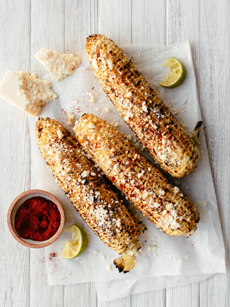TIP OF THE DAY: Mexican Elote & Variations For A DIY Party Bar
|
|
After Labor Day, supplies of fresh summer corn start to dwindle. So here’s an idea for a cocktail party with family, friends and neighbors: ears of corn and cocktails, Mexican-style. By that we mean: elotes, Margaritas and agua fresca (non-alcoholic). Elote (ay-LOW-tay, plural elotes), meaning tender corn cob, derives from the Nahuatl elotitutl (Nahuatl, the language of the Aztecs, is still spoken today). Elote is a popular street food; typically grilled on a stick on the vendor’s cart, then brushed with melted butter or mayonnaise, rolled in cotija or queso fresco crumbles, and dusted with chile powder and salt (photo #1). It’s served with a lime wedge to squeeze over the corn. More modern variations use sour cream (called crema in Mexico) instead of the butter or mayo, and liquid cheese instead of the crumbles (please, no!). Ready to cook? The elotes are usually boiled at home and transported wrapped in their husks by the elotero (the vendor). Once on the street cart, they can be served hot from the warming drawer, or grilled over a brazier to char some of the kernels. These grilled ears are called elotes asados (photo #5). Hacks: Classic Toppings If you want to offer options in addition to the classic elote garnishes, here are some variations. Group the ingredients by nationality on the DIY table, along with signage indicating the nationality. Note that except for Mexican elote, these are flavor ideas we created. They are not served in their designated country. Corn as we know it today is very different from the wild corn that was discovered and cultivated by the peoples living in what is now Mexico. It is a cereal grain, and the original wild grass, called teosinte, had thin sprigs with tiny kernels (” rel=”noopener” target=”_blank”>see image). Scientists believe that people in central Mexico developed corn at least 7,000 years ago. Over the millennia, the ears of maize (corn) we know today were bred to be larger and larger, with larger kernels. These substantial ears of maize became the staple crop. It spread north into the southwestern U.S. and south to Peru. About 1,000 years ago, as Native Americans migrated north across the continent, they brought corn with them. When Columbus “discovered” America, he also “discovered” corn. The sweet corn we enjoy today, which occurred as a spontaneous mutation of field corn, is a family of cultivars of maize. For the biology geeks among us, the genus and species of maize is Zea mays; sweet corn is Zea mays convar. saccharata var. rugosa. Zea is the Greek word for single-grained wheat, and was employed by botanists to name the species of large grasses that have edible components—i.e., the grains. Botanically, the grain is a type of fruit called a caryopsis, composed of the endosperm, germ, and bran. |
|
|
________________ *If using wood sticks, remember to soak them before adding the corn and grilling. †Cilantro is not typically offered in Mexico, but we like the flavor. **Cheddar cheese powder is the best way to make cheese corn at home. ‡Herbes de Provence are blend of herbs from the France region of Provence. It can include any assortment of bay leaf, chervil, fennel, marjoram, mint, rosemary, summer savory, tarragon and thyme. The commercial blends typically comprise savory, marjoram, rosemary, thyme and sometimes, oregano or lavender. ‡‡Recipe for Barbecue Seasoning: Combine 1 tablespoon smoked paprika, 2 teaspoons brown sugar, 1½ teaspoons salt, 1 teaspoon celery salt, 1 teaspoon dry mustard, 1 teaspoon garlic powder, ½ teaspoon black pepper.
|
||




